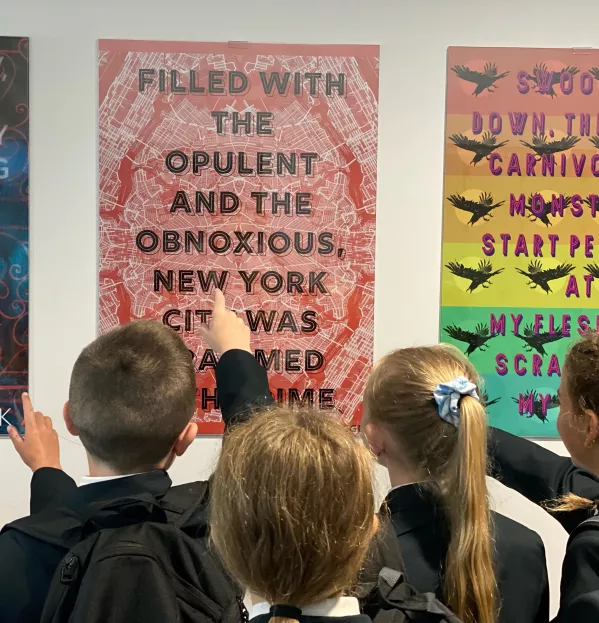- Home
- Teaching & Learning
- Secondary
- How we’re using school corridors to boost student writing
How we’re using school corridors to boost student writing

So much of what happens in an English lesson is written in exercise books, marked by the teacher and then, once feedback has been given, just lives on a shelf or in a cupboard.
Students’ words - the beautifully crafted sentences - stay locked in their books, never to be celebrated beyond the classroom.
This is something we decided to change: by creating beautiful posters of our students’ compositions and using these to liven up our school corridors.
I know that this might raise a few eyebrows. While there has been a great deal of grandstanding on X (formerly known as Twitter) and other social media platforms about schools that have their corridors papered with corporate-style posters listing their “values” and expectations, so that staff don’t have to worry about constantly drilling these into students, the idea of taking time to embellish corridors with materials that aren’t also immediately “useful” might seem very questionable.
I get it. As teachers, time is one of the most precious commodities we have.
However, when our head of English, Emilio Chain Lopez, shared with me the power and brilliance of his composition lessons, we both felt compelled to celebrate and recognise the art of the beautiful sentence.
Boosting writing composition
“Our five-year writing curriculum is continually evolving,” Chain Lopez says. “We teach writing with a focus on vocabulary, sentence level work and weekly extended writing tasks known as ‘compositions’.
“Seven years ago, we were looking for a routine that would give our students the chance to engage in weekly extended writing. Essentially, we wanted to provide them with regular opportunities to, as a 2019 publication by the English and Media Centre states, ‘just write’.”
Inspired by his own research and a Chris Curtis blog describing a weekly 200-word challenge his students completed, Chain Lopez’s composition lessons soon began to take shape.
“An important initial move was aligning the weekly compositions with our curriculum,” Chain Lopez says.
“Year 7, for example, begins with compositions focusing on Greek myths, as their core text for the autumn term is the Iliad. Year 8s, who study War of the Worlds, undertake science-fiction-inspired compositions.”
Read more:
- Inside the primary writing wars
- Is this the best way to teach writing in KS3?
- How schools are getting writing wrong
For each composition task there are word-, sentence- and paragraph-level targets reflecting specific focus areas that are appropriate to each year group, Chain Lopez explains.
And, he continues, this practice has really helped to develop students’ writing - improving their “syntactic fluency” and increasing their writing stamina, while also helping them to see writing as “great fun”. “If this sounds a little too prescriptive, believe me when I say it isn’t,” Chain Lopez stresses.
Students’ writing is, he says, “never solely judged by the dull edicts of a marking rubric”, and their successes are uniquely celebrated through an “ever-changing array of student composition sentence posters”, which grace the walls of the English department corridor.
Creative writing: celebrating students’ work
So, how does the poster element work? Well, that’s where I come in, in my role as head of art.
Every now and again, when English teachers are marking students’ compositions, a stunningly crafted sentence will catch their eye. When this happens, they copy it into an email to me.
From that, I consider the imagery and font that would work well with the nature of the sentence and design a dedicated poster in Photoshop, making sure the sentence itself is the focus of attention. These posters are then framed and hung in the corridor.
The corridor is now nearly full of A1 Perspex frames. When it is full, the posters will be swapped over at regular intervals and the old posters will be given to the students who first composed the sentences on them.
Parents love seeing the posters when they come to the school. Students are thrilled to see a simple sentence from their weekly composition elevated in such a way. It has become quite a motivator for teachers and students to compose ever more brilliant sentences.
Yes, it does take me a little time to make each one, but I find it quite a cathartic thing to do at the end of a day and when a fresh sentence is on display, there is always a crowd around it, reading it and recognising its brilliance. So, that makes it more than worth it.
Pete Jones is head of art and assistant headteacher at Les Quennevais School in Jersey
You need a Tes subscription to read this article
Subscribe now to read this article and get other subscriber-only content:
- Unlimited access to all Tes magazine content
- Exclusive subscriber-only stories
- Award-winning email newsletters
Already a subscriber? Log in
You need a subscription to read this article
Subscribe now to read this article and get other subscriber-only content, including:
- Unlimited access to all Tes magazine content
- Exclusive subscriber-only stories
- Award-winning email newsletters
topics in this article



